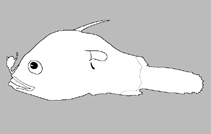http://www.fishbase.org/Summary/speciesSummary.php?genusname=Dolopichthys&speciesname=dinema ---> http://192.134.151.83/Summary/speciesSummary.php?genusname=Dolopichthys&speciesname=dinema
http://192.134.151.83/Summary/speciesSummary.php?genusname=Dolopichthys&speciesname=dinema ---> https://fishbase.mnhn.fr/Summary/speciesSummary.php?genusname=Dolopichthys&speciesname=dinema
https://fishbase.mnhn.fr/Summary/speciesSummary.php?genusname=Dolopichthys&speciesname=dinema ---> https://fishbase.mnhn.fr/summary/Dolopichthys-dinema.html
Dolopichthys dinema

You can
sponsor
this page
Common name (e.g. trout)
Genus + Species (e.g. Gadus morhua)
-

-
About this page
-
Languages
-
User feedbacks
-
Citation
-
Uploads
-
Related species
-


 Add your observation in
Fish Watcher
Upload your
photos
and
videos
Add your observation in
Fish Watcher
Upload your
photos
and
videos
Google image
 No image available for this species;
No image available for this species;
drawing shows typical species in Oneirodidae.
Teleostei (teleosts) >
Lophiiformes
(Anglerfishes) >
Oneirodidae
(Dreamers)
Etymology:
Dolopichthys:
Greek, 'dolops' or 'dolopos' = ambusher + Greek, 'ichthys' = fish (meaning "a fish that attacks by surprise") (Ref.
86949
)
.
Environment: milieu / climate zone / depth range / distribution range
Ecology
Marine; bathypelagic; depth range 0 - 700 m (Ref.
26282
). Deep-water
Eastern Central Atlantic.
Size / Weight / Age
Maturity: L
m
?
range ? - ? cm
Max length : 2.2 cm TL male/unsexed; (Ref.
10524
)
Short description
Morphology
|
Morphometrics
Dorsal
soft rays
(total): 7;
Anal
soft rays
: 6. Characterized by having two tapering filaments on dorsal midline of escal bulb, each darkly pigmented except for distal one-half to one fourth of length ; posterior filament twice as long as anterior filament, 25-26.7% of illicium length; 2 simple, short, unpigmented tapering appendages placed bilaterally on dorsal surface of escal bulb posterior to long tapering filaments; swollen basal part of compressed posterior escal appendage without pigment; presence of connecting membrane between anterior and posterior filaments of posterior escal appendage; teeth on lower jaw 35-39; teeth on vomer 2; dorsal fin rays 7; anal fin rays 6; pectoral fin rays 19-20 (Ref.
86949
).
Mesopelagic.
Life cycle and mating behavior
Maturity
|
Reproduction
|
Spawning
|
Eggs
|
Fecundity
|
Larvae
Bertelsen, E.
, 1990. Oneirodidae. p. 498-507. In J.C. Quero, J.C. Hureau, C. Karrer, A. Post, and L. Saldanha (eds.) Check-list of the fishes of the eastern tropical Atlantic (CLOFETA). JNICT, Lisbon; SEI, Paris; and UNESCO, Paris. Vol. 1. (Ref.
10524
)
IUCN Red List Status (Ref.
130435
)
Least Concern (LC)
; Date assessed:
09 May 2013
CITES
Not Evaluated
Not Evaluated
Threat to humans
Harmless
Human uses
FAO - Publication:
search
|
FishSource
|
More information
Countries
FAO areas
Ecosystems
Occurrences
Introductions
Stocks
Ecology
Diet
Food items
Food consumption
Ration
Common names
Synonyms
Metabolism
Predators
Ecotoxicology
Reproduction
Maturity
Spawning
Spawning aggregation
Fecundity
Eggs
Egg development
Age/Size
Growth
Length-weight
Length-length
Length-frequencies
Morphometrics
Morphology
Larvae
Larval dynamics
Recruitment
Abundance
BRUVS
References
Aquaculture
Aquaculture profile
Strains
Genetics
Electrophoreses
Heritability
Diseases
Processing
Nutrients
Mass conversion
Collaborators
Pictures
Stamps, Coins Misc.
Sounds
Ciguatera
Speed
Swim. type
Gill area
Otoliths
Brains
Vision
Tools
E-book
|
Field guide
|
Length-frequency wizard
|
Life-history tool
|
Point map
|
Classification Tree
|
Catch-MSY
|
Special reports
Check for Aquarium maintenance
|
Check for Species Fact Sheets
|
Check for Aquaculture Fact Sheets
Download XML
Summary page
|
Point data
|
Common names
|
Photos
Internet sources
AFORO (otoliths) |
Aquatic Commons
|
BHL
|
Cloffa
|
BOLDSystems
|
Websites from users
|
Check FishWatcher
|
CISTI
|
Catalog of Fishes
:
genus
,
species
|
DiscoverLife
|
ECOTOX
| FAO - Publication:
search
|
Faunafri
| Fishipedia |
Fishtrace
| GenBank:
genome
,
nucleotide
| GloBI |
Google Books
|
Google Scholar
|
Google
| IGFA World Record |
MitoFish
|
Otolith Atlas of Taiwan Fishes
|
PubMed
| Reef Life Survey | Socotra Atlas |
Tree of Life
| Wikipedia:
Go
,
Search
| World Records Freshwater Fishing |
Zoobank
|
Zoological Record
Estimates based on models
Preferred temperature (Ref.
123201
): 11 - 16.8, mean 14.1 °C (based on 18 cells).
Phylogenetic diversity index (Ref.
82804
): PD
50
= 0.5078 [Uniqueness, from 0.5 = low to 2.0 = high].
Bayesian length-weight: a=0.01995 (0.00906 - 0.04395), b=3.01 (2.83 - 3.19), in cm total length, based on all LWR estimates for this body shape (Ref.
93245
).
Trophic level (Ref.
69278
): 3.0 ±0.4 se; based on size and trophs of closest relatives
Resilience (Ref.
120179
): High, minimum population doubling time less than 15 months (Preliminary K or Fecundity.).
Fishing Vulnerability (Ref.
59153
): Low vulnerability (10 of 100).
Back to Search
Random Species
Back to Top
Accessed through:
Not available
FishBase mirror site :
localhost
Page last modified by :
mrius-barile
- 20 July 2016
Fatal error
: Uncaught ArgumentCountError: Too few arguments to function checkEcotox(), 1 passed in /var/www/html/summary/speciessummary.php on line 2304 and exactly 3 expected in /var/www/html/includes/speciessummary.lib.php:2579 Stack trace: #0 /var/www/html/summary/speciessummary.php(2304): checkEcotox() #1 {main} thrown in
/var/www/html/includes/speciessummary.lib.php
on line
2579
|